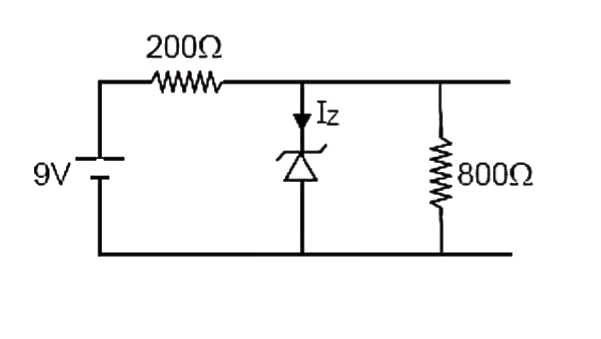In a p−n junction diode, the currect I can expressed as I=I0exp(eV2kBT−1) where I0 is called the reverse saturation current, V is the voltage across the diode and is positive for forward bias and negative for reverse bias, and I is the current through the diode, KB is the Boltzmann constant (8.6×10−5eV/K) and T is the absolute temperature. If for a given diode Io=5×10−12A and T=300K, then
(a) What will be the forward current at a formward voltage of 0.6V ?
(b) What will be the increase in the current if the voltage across the diode is increased to 0.7V ?
( c) What is the dynamic resistance ?
(d) What will be current if reverse bias voltage changes from 1V to 2V ?
In a p-n junction diode, the expression for current is given as:
I=Ioexp(eV2kBT−1)
Where,
I0 = Reverse saturation current =5×10−12A
T = Absolute temperature = 300 K
kB = Boltzmann constant =8.6×10−5eV/K=1.376×10−23JK−1
V = Voltage across the diode
(a) Forward voltage, V = 0.6 V
=5×10−12[exp(1.6×10−19×0.61.376×10−23×300)−1]
∴ Current, I
=5×10−12×exp[22.36]=0.0256A
Therefore, the forward current is about 0.0256 A.
(b) For forward voltage, V’ = 0.7 V, we can write:
I=5×10−12[exp(1.6×10−19×0.71.376×10−23×300−1)]
=5×10−12×exp[26.25]=1.257 A
Hence, the increase in current, ΔI=I'−I
= 1.257 − 0.0256 = 1.23 A
=CHange in voltageCHange in current
(c) Dynamic resistance
0.7−0.61.23=0.11.23=0.081Ω
(d) If the reverse bias voltage changes from 1 V to 2 V, then the current (I) will almost remain equal to I0 in both cases. Therefore, the dynamic resistance in the reverse bias will be infinite.
Topper's Solved these Questions
- SEMICONDUCTOR ELECTRONICS MATERIALS DEVICES AND SIMPLE CIRCUITSBOOK - NCERT ENGLISHCHAPTER - SEMICONDUCTOR ELECTRONICS MATERIALS DEVICES AND SIMPLE CIRCUITSEXERCISE - Exercise
15 Videos
- RAY OPTICS AND OPTICAL INSTRUMENTSBOOK - NCERT ENGLISHCHAPTER - RAY OPTICS AND OPTICAL INSTRUMENTSEXERCISE - Exercise
32 Videos
- WAVE OPTICS BOOK - NCERT ENGLISHCHAPTER - WAVE OPTICS EXERCISE - Exercise
21 Videos
Similar Questions
Knowledge Check
When the voltage drop across a p.n junction diode is increased from 0.65V to 0.70V, the change in the diode current is 5mA. What is the dynamic resistance of the diode?
A5ΩB10ΩC20ΩD25Ω
Assuming that the junction diode is ideal the current through the diode is :-
_E01_333_Q01.png)
View SolutionWhen the voltage drop across a p-n junction is increased from 0.80 V to 0.82 V, the change in the diode current is 20 mA. What is the dynamic resistance of the diode ?
View SolutionIn the following diagram, is the junction diode forward biased or reverse biased ?

View SolutionHow is forward biasing different from reverse biasing in a p-n junction diode?
View SolutionIn a p-n junction diode the value of drift current through depletion region
View SolutionConsider a p-n junction diode having the characteristic i=i0(eeV/kT−1)where i0=20(μ)A. The diode is operated at T=300K. (a) Find the current through the diode when a voltage of 300 mV is applied across it in forward bias, (b) At what voltage does the current double?
View SolutionIn the figure, the reverse breakdown voltage of a Zener diode is 5.6V, then the current IZ through the diode is

View Solution
